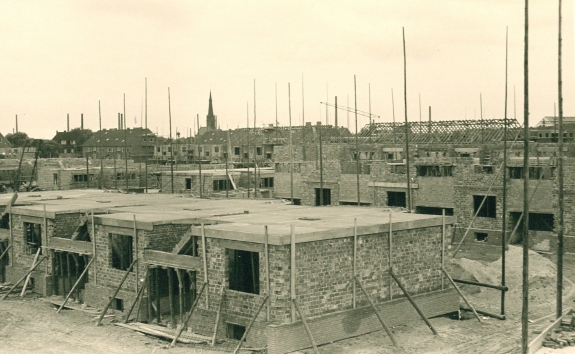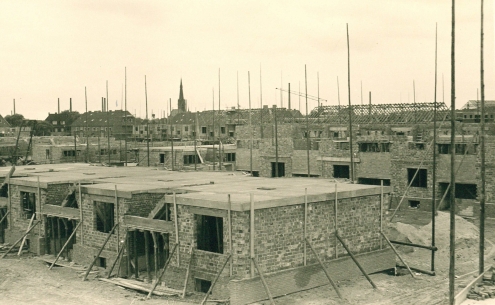Photo of the month - July 2023
The development of an urban district: the Giethorst settlement
After the destruction of the war in 1945, the housing shortage in the city of Bocholt was very great. At the beginning, only dwellings were allowed to be rebuilt. There was a ban on taking in displaced persons, and those who had rooms available had to rent them out. A little later, however, completely new housing estates for about 2,000 people seeking housing were built within the city limits. At the beginning of the 1950s, this included the area behind the Emschermann laundry along Burloer Weg in the northeast, which was popularly called "Giethorst".
This word is the name of an old farmstead outside the eastern city gate, which was already uninhabited in 1606.
From the ideas competition to the urban settlement
In February 1953, as part of the reconstruction programme of the city and the non-profit building societies, Ludwig Kayser, the head of the city, announced that funds were available for 449 new housing units throughout the city. In the first construction phase, 39 two- to four-room flats were built in the Giethorst housing estate, which the Bocholter Wohnungsbaugesellschaft (BWG) began building in the middle of 1953.
In a second construction phase, two blocks of 19 additional flats were built. After the first homes had been occupied at the beginning of 1954, the city announced a competition for ideas worth 6,000 DM (winner's prize) for the entire Giethorst district, where about 500 flats were to be built with financial help from the state of North Rhine-Westphalia. The competition was won by Peter Poelzig, a retired city architect from Duisburg-Wedau. Under his leadership, the construction of the housing estate began in November 1954 with 14 further construction phases in the north-east of Bocholt with the participation of BWG and the Bocholter Bauverein. The architect's development plan provided for the construction of 513 flats, 413 in owner-occupied houses and 100 rented flats. The investment sum was about DM 8.8 million.
Completion in autumn 1956
Work on completing the settlement was carried out at full speed. At times, there was even talk of the Giethorst "command post" or a "major battlefield" with hundreds of workers from the construction industry. The photo shows the shell of the buildings on what was later to become Schollstraße.
The largest housing estate in the city of Bocholt after the war was finally completed by and large in the autumn of 1956. Meanwhile, the completion of the Edith Stein School there was not long in coming.




